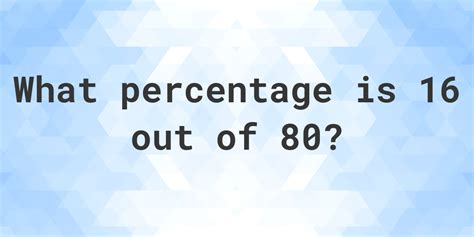What Percent Of 80 Is 16
Kalali
Apr 06, 2025 · 4 min read

Table of Contents
What Percent of 80 is 16? A Comprehensive Guide to Percentage Calculations
Percentage calculations are fundamental to numerous aspects of daily life, from calculating discounts and sales tax to understanding financial reports and statistical data. Knowing how to determine what percentage one number represents of another is a crucial skill. This article delves deep into solving the problem "What percent of 80 is 16?", exploring different methods, explaining the underlying concepts, and providing practical applications. We'll move beyond simply finding the answer to understand the broader implications of percentage calculations and how to apply this knowledge effectively.
Understanding Percentages: The Basics
Before diving into the specific problem, let's solidify our understanding of percentages. A percentage is simply a fraction expressed as a part of 100. The symbol "%" represents "per hundred" or "out of 100". For example, 50% means 50 out of 100, or 50/100, which simplifies to 1/2 or 0.5.
Key Terms and Concepts
- Percentage: A ratio expressed as a fraction of 100.
- Part: The smaller number that represents a portion of the whole.
- Whole: The larger number representing the total amount.
- Rate: The percentage that the part represents of the whole.
Method 1: Using the Formula
The most straightforward method to determine what percent of 80 is 16 is to use the percentage formula:
(Part / Whole) * 100 = Percentage
In this case:
- Part = 16
- Whole = 80
Substituting these values into the formula:
(16 / 80) * 100 = Percentage
Simplifying the fraction:
(1/5) * 100 = 20
Therefore, 16 is 20% of 80.
Method 2: Setting up a Proportion
Another effective method involves setting up a proportion. A proportion is an equation stating that two ratios are equal. We can represent the problem as:
16/80 = x/100
Where 'x' represents the unknown percentage.
To solve for 'x', we can cross-multiply:
16 * 100 = 80 * x
1600 = 80x
Now, divide both sides by 80:
x = 1600 / 80
x = 20
Again, we find that 16 is 20% of 80.
Method 3: Using Decimal Equivalents
Percentages can also be expressed as decimals. To convert a percentage to a decimal, divide the percentage by 100. For example, 20% is equivalent to 0.20.
We can use this method to solve our problem. First, we find what fraction of 80 is 16:
16 / 80 = 0.20
Then, convert the decimal to a percentage by multiplying by 100:
0.20 * 100 = 20%
This confirms that 16 is 20% of 80.
Practical Applications: Real-World Examples
Understanding percentage calculations has numerous practical applications in various scenarios. Here are a few examples:
1. Sales and Discounts:
Imagine a store offers a 20% discount on an item originally priced at $80. Using our knowledge, we know that a 20% discount is equal to $16 (20% of 80). The final price after the discount would be $64 ($80 - $16).
2. Tax Calculations:
If a sales tax rate is 20%, and you buy an item for $80, the tax amount would be $16 (20% of 80). Your total cost, including tax, would be $96 ($80 + $16).
3. Grade Calculations:
Let's say you scored 16 points out of a possible 80 points on a test. This represents a 20% score.
4. Financial Analysis:
Percentage calculations are vital in financial statements. For instance, comparing profit margins, understanding growth rates, and analyzing investment returns all rely heavily on percentages.
5. Statistical Data:
In statistics, percentages are used to represent proportions within datasets, making complex data easier to interpret and understand.
Beyond the Basics: Advanced Percentage Problems
While the problem "What percent of 80 is 16?" is a relatively straightforward calculation, the underlying principles can be applied to more complex scenarios.
Finding the Whole Given the Part and Percentage:
Let's say you know that 20% of a number is 16. How would you find the original number (the whole)?
We can set up the equation as:
0.20 * x = 16
Solving for x:
x = 16 / 0.20
x = 80
Therefore, the whole number is 80.
Finding the Part Given the Whole and Percentage:
If you know that 20% of 80 is what number?
We can calculate this as:
0.20 * 80 = 16
Therefore, 20% of 80 is 16.
Mastering Percentage Calculations: Tips and Tricks
Here are some tips to help you master percentage calculations:
- Practice Regularly: The more you practice, the more comfortable you'll become with these calculations.
- Use Different Methods: Try different methods (formula, proportion, decimal equivalents) to reinforce your understanding.
- Visual Aids: Using diagrams or charts can help visualize the problem.
- Check Your Work: Always check your answer to ensure accuracy.
- Real-World Application: Apply your knowledge to real-world scenarios to improve retention.
Conclusion: The Power of Percentages
The simple question "What percent of 80 is 16?" unveils the power and versatility of percentage calculations. Beyond just finding the answer (20%), understanding the underlying methods and their practical applications is crucial. Mastering percentage calculations equips you with a valuable skill applicable in various aspects of life, from personal finance to professional endeavors. By consistently practicing and applying these techniques, you can confidently tackle more complex percentage problems and utilize this fundamental skill to its full potential.
Latest Posts
Latest Posts
-
How Many Inches In 5 5 Feet
Apr 09, 2025
-
What Is 60 Inches In Ft
Apr 09, 2025
-
How Many Cm Is 14 5 Inches
Apr 09, 2025
-
How Much Is 25 Ounces In Ml
Apr 09, 2025
Related Post
Thank you for visiting our website which covers about What Percent Of 80 Is 16 . We hope the information provided has been useful to you. Feel free to contact us if you have any questions or need further assistance. See you next time and don't miss to bookmark.